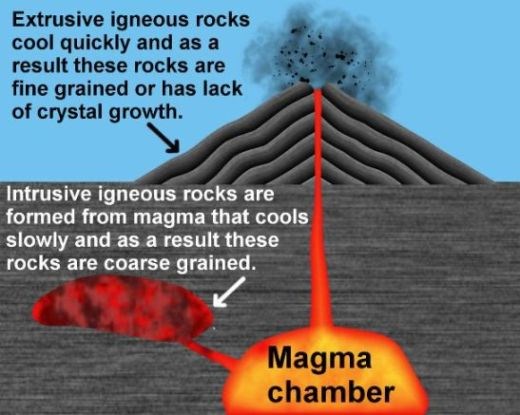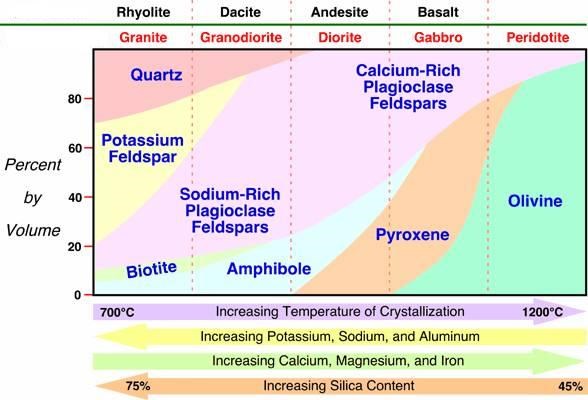ESP
En las coordenadas indicadas encontrará la estatua de Federico García Lorca, poeta, dramaturgo y director de teatro español. Para este EarthCache estamos interesados en el pedestal de esta estatua. El pedestal de esta estatua fue hecho de gabro, y el gabro es un tipo de roca ígnea. Gabro es una roca de color oscuro que contiene los siguientes minerales: piroxeno, plagioclasa y cantidades menores de anfíbol y olivino.
Rocas ígneas
Las rocas ígneas se forman por enfriamiento de magma o lava caliente y por su solidificación. Aunque tanto el magma como la lava son esencialmente roca fundida, el magma es roca fundida mientras aún está debajo de la superficie y la lava es roca fundida en la superficie del planeta, generalmente expulsada por un volcán durante una erupción. Si la roca se forma a partir de magma también se denomina plutónica y si se forma a partir de lava se denomina volcánica. El término "plutónico" proviene del nombre del dios clásico del inframundo, Plutón, y el término "volcánico" proviene del hecho de que la roca se forma a partir de la erupción de lava de un volcán.
Igneous Rocks

Intrusivo o Extrusivo
Las rocas plutónicas también se denominan rocas intrusivas. Eso significa que el magma es empujado lentamente hacia arriba desde el manto dentro de la tierra y se entromete por la fuerza en cualquier grieta o espacio que pueda encontrar. Por otro lado, las rocas volcánicas también se denominan rocas extrusivas porque se forman cuando el magma caliente sale a la superficie del planeta en forma de lava. El proceso de enfriamiento del magma caliente en las profundidades de la superficie del planeta dura mucho más que el enfriamiento de la lava caliente en la superficie del planeta. Dado que dura más, los cristales más grandes pueden crecer durante el proceso de solidificación de las rocas intrusivas en comparación con las rocas extrusivas.
Fanerítica o Afanítica
Durante el proceso de enfriamiento y solidificación de magma o lava, el proceso de cristalización o formación de cristales puede ocurrir o no. Entonces, eso significa que hay rocas ígneas con cristales y rocas ígneas sin cristales. Aquellas rocas ígneas que se forman con cristales se pueden dividir en aquellas que tienen cristales lo suficientemente grandes para ser vistos a simple vista (también se les llama rocas faneríticas), y aquellas que tienen cristales demasiado pequeños para ser vistos a simple vista (son también se denominan rocas afaníticas). Las rocas faneríticas también son rocas intrusivas, porque tienen más tiempo para desarrollar cristales más grandes durante el enfriamiento del magma en las profundidades de la superficie del planeta. Las rocas afaníticas también son rocas extrusivas porque la lava se enfría en la superficie del planeta y sucede mucho más rápido que debajo de la superficie.
Fino, Medio o Grueso
Los cristales en las rocas ígneas se ven en forma de granos de diferentes colores y tamaños. En cuanto a su tamaño, los granos pueden ser: (1) de grano fino (el diámetro de los granos es menor a 1 milímetro), (2) de grano medio (el diámetro de los granos está entre 1 y 5 milímetros), y (3) grueso -granulado (el diámetro de los granos es mayor de 5 milímetros). Las rocas intrusivas o plutónicas suelen tener cristales más grandes porque el proceso de enfriamiento y solidificación dura mucho más debajo de la superficie del planeta. Por lo tanto, generalmente son de grano grueso. Las rocas extrusivas o volcánicas suelen tener cristales más pequeños porque el proceso de enfriamiento y solidificación dura mucho menos en la superficie del planeta. Por lo tanto, generalmente son de grano fino.
Máfico o Félsico
Las rocas ígneas se pueden clasificar según su composición mineral en dos grupos: máficas y félsicas. Los minerales máficos son de color oscuro y los minerales máficos comunes que forman rocas incluyen olivino, piroxeno, anfíbol y biotita. Estos minerales son minerales de silicato que son ricos en magnesio y hierro. El término "mafic" se deriva del uso de "ma-" de "magnesio" y "-fic" de "ferric". Los minerales félsicos son de color claro y los minerales formadores de rocas comunes incluyen feldespato y cuarzo. Los minerales félsicos también son minerales de silicato, pero son ricos en silicio, oxígeno, aluminio, sodio y potasio. El término "felsic" se deriva del uso de "fel-" de "feldspar" y "-sic" de "silica".
Composición mineral de las rocas ígneas

Registro de tareas
Para registrar este EarthCache responde las siguientes preguntas:
Observe los granos de cristales dentro del gabro para responder las siguientes preguntas:
1. ¿Es gabro roca fanerítica o roca afanítica? ¿Por qué?
2. ¿El gabro es una roca de grano fino, de grano medio o de grano grueso? ¿Por qué?
3. ¿Se forma el gabro muy por debajo de la superficie del planeta o en la superficie del planeta? ¿Por qué?
4. ¿El gabro se forma a partir de magma o de lava? ¿Por qué?
5. Observa el color del gabro. ¿El gabro es roca máfica o félsica? ¿Por qué?
6. Adjunta una foto tuya, tu GPS o apodo escrito en papel, palma, camiseta, etc.
Envíe respuestas a través de su perfil en geocaching.com, ¡NO en su registro! No tienes que esperar a que se confirmen tus respuestas. Una vez que envíe sus respuestas, siéntase libre de registrar este EarthCache como encontrado. Si sus respuestas son incorrectas nos pondremos en contacto con usted.

ENG
At the listed coordinates you will find statue of Federico Garcia Lorca who was a Spanish poet, playwright, and theatre director. For this EarthCache we are interested for the plinth of this statue. The plinth of this statue was made from gabbro, and gabbro is type of igneous rock. Gabbro is a dark-colored rock that contains following minerals: pyroxene, plagioclase, and minor amounts of amphibole and olivine.
Igneous Rocks
Igneous rocks are one of three large groups of rocks (the other two are sedimentary and metamorphic). Igneous rocks are formed by cooling of hot magma or lava and by its solidification. Although both magma and lava are essentially molten rock, the magma is molten rock while it is still below the surface and lava is molten rock on the surface of planet usually expelled by a volcano during an eruption. If the rock is formed from magma it is also called plutonic and if it is formed from lava it is called volcanic. The term “plutonic” came from the name of classical god of the underworld - Pluto, and the term “volcanic” came from the fact that the rock is formed from lava erupted from a volcano.
Igneous Rocks

Intrusive or Extrusive
Plutonic rocks are also called intrusive rocks. That means that magma is slowly pushed up from the mantle within the earth and it intrudes by force into any cracks or spaces it can find. On the other hand, volcanic rocks are also called extrusive rocks because they are formed when hot magma extrudes onto the surface of planet as lava. The process of cooling of hot magma deep below surface of planet lasts much longer than cooling of hot lava on the surface of planet. Since it lasts longer, the larger crystals can grow during the process of solidification of intrusive rocks when compared to extrusive rocks.
Phaneritic or Aphanitic
During the process of cooling and solidification of magma or lava, the process of crystallization or formation of crystals might or might not happen. So, that means that there are igneous rocks with crystals and igneous rocks without crystals. Those igneous rocks that are formed with crystals can be divided into those that have crystals large enough to be seen by the naked eye (they are also called phaneritic rocks), and those that have crystals too small to be seen by the naked eye (they are also called aphanitic rocks). Phaneritic rocks are also intrusive rocks, because they have more time to develop larger crystals during cooling of magma deep below surface of planet. Aphanitic rocks are also extrusive rocks because lava cools on surface of the planet and it happens much faster than below surface.
Fine, Medium or Coarse
Crystals in igneous rocks are seen in the form of grains of different colors and different sizes. Regarding their size, grains can be: (1) fine-grained (diameter of the grains is smaller than 1 millimeter), (2) medium-grained (diameter of the grains is between 1 and 5 millimeters), and (3) coarse-grained (diameter of the grains is larger than 5 millimeters). Intrusive or plutonic rocks usually have larger crystals because the process of cooling and solidification lasts much longer below the surface of planet. So, they are usually coarse-grained. Extrusive or volcanic rocks usually have smaller crystals because the process of cooling and solidification lasts much shorter on the surface of planet. So, they are usually fine-grained.
Mafic or Felsic
Igneous rocks can be categorized according to their mineral composition into two groups: mafic and felsic. Mafic minerals are dark in color, and common rock-forming mafic minerals include olivine, pyroxene, amphibole, and biotite. These minerals are silicate minerals that are rich in magnesium and iron. The term “mafic” is derived from using the “ma-“ from “magnesium” and the “-fic” from the “ferric”. Felsic minerals are light in color, and common rock-forming minerals include feldspar and quartz. Felsic minerals are also silicate minerals but they are rich in silicon, oxygen, aluminium, sodium, and potassium. The term “felsic” is derived from using the “fel-“ from “feldspar” and “-sic” from “silica”.
Mineral Composition of Igneous Rocks

Logging Tasks
To log this EarthCache answer the following questions:
Observe the grains of crystals within gabbro to answer the following questions:
1. Is gabbro phaneritic rock or aphanitic rock? Why?
2. Is gabbro fine-grained, medium-grained or coarse-grained rock? Why?
3. Is gabbro formed deep below the surface of planet or on the surface of planet? Why?
4. Is gabbro formed from magma or from lava? Why?
5. Observe the color of gabbro. Is gabbro mafic or felsic rock? Why?
6. Attach a photo of you, your GPS or nickname written on paper, palm, t-shirt, etc.
Send answers via profile on geocaching.com, NOT in your log! You do not have to wait for your answers to be confirmed. Once you submit your answers feel free to log this EarthCache as found. If your answers are wrong we will contact you.